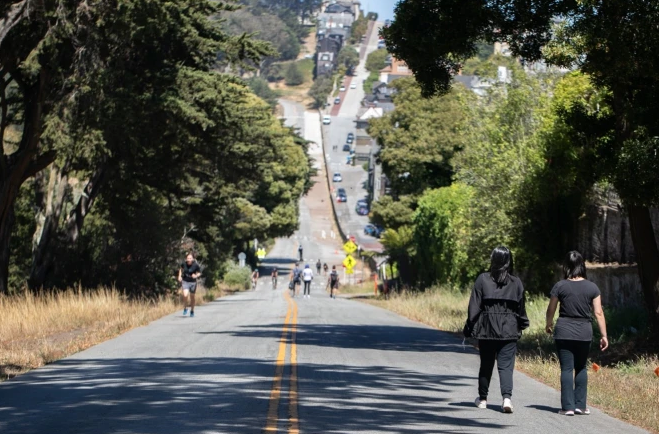Note: GJEL Accident Attorneys regularly sponsors coverage on Streetsblog San Francisco and Streetsblog California. Unless noted in the story, GJEL Accident Attorneys is not consulted for the content or editorial direction of the sponsored content.
With San Francisco, Oakland and other cities' Slow Streets movements, one could be forgiven for overlooking another big Bay Area entity rethinking how streets are used: the Presidio Trust, a federal agency, has its own COVID-emergency program to force motorists to share some asphalt. And, as with the cities that surround it, the managers of the Presidio's streets are now looking at making Slow Streets a permanent feature.
From a Presidio release:
The Presidio Slow Streets program has proven popular, and now we’re exploring what aspects of it to formalize through signage, traffic barricades, and traffic calming for the long-term benefit of park visitors. To do this, we want to hear what you like and what we can improve.
The Presidio is receiving public comment on its Slow Streets in two ways: 1) Online, through Nov. 30, at this site. 2) And in person on Saturday, November 13, 2021, between 10 a.m. and 2 p.m., on the Ecology Trail at the intersection of Arguello Boulevard and West Pacific Avenue.
Some more background on Slow Streets from the Presidio's release:
The Presidio Trust implemented the Presidio Slow Streets program in 2020 to provide additional space for recreation during the COVID-19 pandemic and to create more opportunities for visitors to enjoy the Presidio. From the beginning, we’ve listened to the community, collected usage data, and adapted the roadways based on this feedback. As we further refine the Slow Streets program we’d like to hear from the community.
Presidio Slow Streets currently include two types of roadways:
- Recreation Zone (Red) – Vehicles are not permitted.
- Slow Street Zone (Yellow) – Vehicle access is limited to residents, tenants, deliveries, and emergency vehicles.
The Presidio transportation department, meanwhile, has made a name for itself pioneering the first Dutch-style roundabout in the Bay Area, complete with a separated and protected bike lane. They've also installed "advisory bike lanes," another Dutch-inspired treatment.






